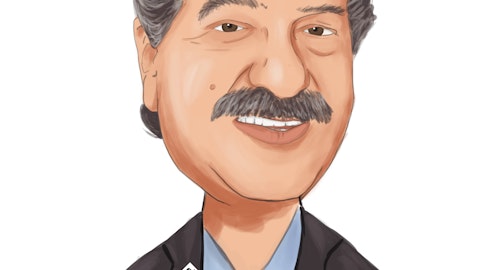Berkshire Hills Bancorp, Inc. (NYSE:BHLB) Q3 2023 Earnings Call Transcript October 20, 2023
Berkshire Hills Bancorp, Inc. beats earnings expectations. Reported EPS is $0.5, expectations were $0.49.
Operator: Good morning, ladies and gentlemen, and welcome to the Berkshire Hills Bancorp Third Quarter 2023 Earnings Conference Call. At this time, all lines are in listen-only mode. Following the presentation, we will conduct a question-and-answer session. [Operator Instructions] This call is being recorded on Friday, October 20, 2023. I would now like to turn the conference over to Kevin Conn. Please go ahead.
Kevin Conn: Good morning, and thank you for joining Berkshire Bank’s third quarter earnings call. My name is Kevin Conn, Investor Relations and Corporate Development Officer. Here with me today are Nitin Mhatre, Chief Executive Officer; Sean Gray, Chief Operating Officer; David Rosato, Chief Financial Officer; and Greg Lindenmuth, Chief Risk Officer. Our remarks will include forward-looking statements and refer to non-GAAP financial measures. Actual results could differ materially from those statements. Please see our legal disclosure on Page 2 of the earnings presentation, referencing forward-looking statements and non-GAAP financial measures. A reconciliation of non-GAAP to GAAP measures is included in our news release. At this time, I’ll turn the call over to Nitin. Nitin?
Nitin Mhatre: Thank you, Kevin. Good morning, everyone. I’ll begin my comments on Slide 3, where you can see the highlights for the third quarter. While the rate environment remains challenging for Berkshire and the overall banking industry, we are encouraged by the trends in our margin that reflects a deceleration in NIM compression. We’re also encouraged by the trends in asset quality and deposit durability. While expenses were flat quarter-over-quarter, given the challenging macroeconomic environment, we will have heightened focus on rationalizing expenses. Some of these initiatives have already begun, and we are exploring all other avenues to create a sustained long-term efficiency improvement. David will discuss this in more detail in his remarks.
Credit is trending in-line with expectations. Charge-offs declined linked quarter and loan loss reserves increased modestly. Operating net income of $21.5 million and operating EPS of $0.50, both declined 9% linked quarter, primarily from a decline in net interest income. Year-to-date EPS of $1.67 is up by 7% year-over-year. Deposits were stable in the third quarter, up 1% linked quarter on an average balance basis, and down 1% on an end-of-period basis. While we’re not immune to the funding cost and mix pressures facing the industry, we believe our deposit base is relatively stable, given our history and long-term relationships with clients in smaller cities across our markets. Average loan balances were up 2% linked quarter, with balanced growth across commercial and consumer loans.
Our balance sheet remains strong. We ended the quarter with common equity Tier 1 ratio of 12.1% and a tangible common equity ratio of 7.67%. We’ve added a page in the appendix on our overall commercial real estate portfolio and updated the appendix page that provides details on our office portfolio, both of which highlight how our portfolio is granular, geographically diverse and resultantly less risky. David will cover some of these metrics in more detail in a few moments. On the BEST strategy front, this quarter marks the start of year three of our three-year BEST program. We continue to rationalize our real estate footprint, including the consolidation of four branches and sale of one office building this past quarter. In continuation of our digitization journey, we launched our new mobile banking app and online banking platform towards the end of the third quarter.
The disruption in our markets has enabled us to opportunistically hire deposit and relationship-focused frontline bankers. We’re also delighted that Mary Anne Callahan has joined our Board of Directors. We’ve included a page with Mary Anne’s bio in the Appendix. Welcome aboard Mary Anne. Slide 4 shows our BEST programs progress on five key performance metrics. As we’ve said in the past, the path to our targets will not be a straight line. We are near the low end of our target range for operating return on assets at 73 basis points and our operating return on tangible common equity, or ROTCE, at 9.27%. We’ve added a new ROTCE calculation to be more consistent with our peers, which David will review in his remarks. Our quarterly PPNR annualizes to $136 million, and our ESG score remains in the top quartile at the 19 percentile nationally.
Our Net Promoter Score in the third quarter came in at 54%, significantly higher than our full year 2022 NPS score of 43%. I want to use this opportunity to thank all of my Berkshire colleagues for their continued hard work and commitment to our vision to be a high-performing relationship-focused community bank. Their commitment to our strategy and dedication to our customers and communities is what brings us together and sets us apart. With that, I’ll turn the call over to David to discuss our financials in more detail. David?
David Rosato: Thank you, Nitin. Slide 5 shows an overview of the quarter. As Nitin mentioned, operating earnings were $21.5 million or $0.50 per fully diluted share, down $0.05 linked quarter and down $0.12 year-over-year. Our net interest margin was 3.18%, down 6 basis points linked quarter and down 30 basis points year-over-year. Net interest income declined $2.4 million or 3% linked quarter and was down $1.8 million or 2% year-over-year. Operating noninterest income was up 2% in the quarter and up 7% year-over-year. Operating expenses were flat versus last quarter and up $3.7 million or 5% year-over-year. Average loans increased $161 million or 2% linked quarter, while average deposits increased $62 million or 1% from the second quarter.
Provision expense for the quarter was $8 million at the midpoint of our July guidance and flat to the second quarter. Net charge-offs were in line with expectations at $5.4 million or 24 basis points of average loans. We increased our allowance for credit losses by $2.6 million in the quarter. Slide 6 shows more detail on our average loan balances which were up $161 million or 2% linked quarter. We had balanced growth across our commercial real estate and residential mortgage books with modest declines in C&I and consumer. Slide 7 shows our average deposit balances. Total deposits increased $62 million or 1% in the quarter and were essentially flat year-over-year. As expected, the deposit mix shifted with a modest decline in noninterest-bearing deposits and an increase in time deposits.

An array of ATM’s in a bustling city, indicative of the company’s banking services. Editorial photo for a financial news article. 8k. –ar 16:9
Noninterest-bearing deposits as a percentage of total average deposits were 26% in the third quarter versus 27% in Q2. Our deposit costs were 181 basis points up 30 basis points from the second quarter. Our deposit beta for the third quarter was 112% and our cumulative beta is 32% through 525 basis points of Fed tightening. Borrowings stood at 9% of total funding on an average balance basis, down from 12% in the second quarter and up from 3% in third quarter of 2022. Turning to Slide 8, we show net interest income. Higher loan volumes provided a lift to the third quarter, while higher deposit costs contributed to the $2.4 million or 3% decrease in net interest income. The $1.8 million or 2% year-over-year decline in net interest income was primarily driven by higher deposit and borrowing costs.
Slide 9 shows fee income, which was up $371,000 or 2% linked quarter. Deposit-related fees were up $221,000. Loan and other fees were down $310,000 in the second quarter. Gain on sale of SBA loans were down $362,000 versus the second quarter due to lower premiums in the market. Wealth management fees were down $102,000 linked quarter. Other fees, which include a securities fair value adjustment of negative $467,000 were higher, primarily driven by the reversal of tax credit amortization. Slide 10 shows our expenses. Expenses were flat linked quarter and are closer to the lower end of the guided range of $73 million to $76 million per quarter. Modest increases in compensation and technology expenses were offset by declines in occupancy and equipment, professional services and other expenses.
GAAP expenses of $76.5 million include $2.6 million of restructuring charges, primarily driven by branch consolidations. Expenses year-over-year were up $3.7 million or 5%, largely driven by higher compensation and technology expenses. The increase in other expenses was primarily driven by higher deposit insurance premiums and loan servicing expense. As we said last quarter, technology spend will normalize over the coming quarters as we reduced costs related to our legacy digital platform. We are committed to managing expenses with discipline and transparency. We have instituted biweekly meetings in which every vendor expense of $25,000 or more and every request for new hires as well as replacement hires above a preset grade level. This granular approach to expense management is starting to have the desired impact of reducing our expense base.
This strategy will ensure that every dollar is thoughtfully spent and is necessary to run the bank efficiently or to grow our revenue and earnings. Slide 11 is a summary of asset quality metrics. Nonperforming loans were down $1.8 million linked quarter and $11.3 million year-over-year. Net charge-offs of $5.4 million or 24 basis points were down $300,000 in the second quarter versus the second quarter. In the top right chart, you can see that Berkshire’s 10-year average net charge-offs to loans averages 27 basis points, and we are currently operating around that normalized level. Net charge-offs included commercial loan charge-offs of $3.2 million and consumer loan charge-offs of $2.2 million. We’ve included a chart in the appendix with Berkshire’s charge-off rates versus the industry since the year 2000.
As Nitin mentioned, we’ve added a page in the appendix on overall CRE exposure. The CRE book is well diversified in terms of geography and collateral type. Credit quality of this portfolio remains strong with nonaccrual loans at 12 basis points of total loans. We also updated the page in the appendix on the office portfolio. As noted last quarter, the weighted average loan-to-value ratios or approximately 60%, and a large majority is in suburban and Class A office space. While current credit quality metrics are benign, we recognize that economic uncertainties exist we are monitoring both new originations and our existing portfolios carefully. We have modestly increased our reserves commensurately. Slide 12 shows returns over the past five quarters on a GAAP and an operating basis.
As you know, the current operating environment is presenting headwinds but we remain highly focused on improving our medium-term performance. I want to highlight several new rows we’ve added to the financial tables at the beginning of the earnings release this quarter. We have been reporting return on tangible common equity with a denominator that excludes the negative AOCI mark from our AFS securities portfolio. We are now also reporting ROTCE with a denominator that includes the negative AOCI mark, which lowers the denominator and increases proxy. Most of our peers calculate return on tangible common equity this way, and we’d encourage you to consider ROTCE figures on an apples-to-apples basis. We are not moving the return on goalposts, but are simply aligning part of our reporting to be more consistent with both peers and larger banks.
Slide 13 shows capital ratios. Our top capital management priority is to deploy capital to support organic loan growth. Secondly, we remain biased towards stock repurchases given our stock prices below tangible book value. In Q3, we repurchased $3.9 million of stock at an average cost of $20.01. We believe Berkshire stock is undervalued given our growth potential and low-risk business model. We will continue to opportunistically repurchase stock. With that, I’d like to turn it back to Nitin for further comments.
Nitin Mhatre: Thank you, David. I’ll close my remarks with comments on the economy, the industry and our positioning. We are fortunate to be operating in the relatively stable markets in the Northeast, which continue to remain on solid footing. We’re facing typical banking industry cyclicality issues such as NIM compression from the inverted yield curve and normalization of credit cycle. Banks do adjust, and we expect margin compression to decline over the next few quarters. While we expect credit costs to increase modestly, they will be significantly lower than the losses during the GFC cycle. We also believe that increased regulatory costs will impact the industry, but are likely to impact larger regional banks or money center banks much more than community banks like Berkshire.
While we can’t operate or control the macro environment, we are focused on controlling what we can and have several levers, including opportunistic hiring for deposit growth de-risking the balance sheet and rigorous expense management. When I started as CEO in early 2021, we faced declining loan balances that we steadily turn into loan growth. We will similarly overcome the current challenges, especially deposits growth and expense management. We remain focused on selective, responsible and profitable organic growth and are confident that we will get bigger while getting better. With that, I’ll turn it over to the operator for questions. Jerry?
See also 12 Most Expensive Luxury RVs in the World in 2023 and 14 Best Consumer Staples Stocks To Buy Now.
Q&A Session
Follow Berkshire Hills Bancorp Inc (NYSE:BHLB)
Follow Berkshire Hills Bancorp Inc (NYSE:BHLB)
Operator: Ladies and gentlemen, we will now begin the question-and-answer session. [Operator Instructions] Our first question comes from Bill Young of RBC Capital Markets. Please go ahead. My apologies. We seem to have an issue there. So, we’ll go to the next question from the line of Mark Fitzgibbon of Piper Sandler.
Mark Fitzgibbon: First question I had, should we expect more branch consolidations and restructuring charges associated with that in coming quarters?
Nitin Mhatre: I think the short answer, Mark, could be, yes. We constantly monitor our geography and opportunities for consolidation while retaining our clients and bankers. So that process will continue. And to that extent, you should continue to expect that.
Mark Fitzgibbon: Okay. And then how about balance sheet restructuring in the fourth quarter given that it looks like rates are going to stay up here for a while. Is that something that you’re contemplating?
David Rosato: Mark, it’s David. Yes, we are constantly thinking about the logic of restructuring the securities portfolio. We’re very similar to a lot of banks where the whole portfolio is underwater. It’s primarily mortgage-backed securities. Some of the durations have lengthened out a little bit. So as you know, very clearly, it’s just taking that equity hit to create a much better run rate going forward. The things that we think about mostly is the future path of interest rates and we’re constantly trying to think through whether we’re close to the turn in rates and if so, it’s probably not the best strategy because that equity hit is large. But it could happen or could not happen in Q4 or even into 2024 at this point.
Mark Fitzgibbon: Okay. That’s a fair answer. And then, I guess at a macro level, can you share with us how you’re thinking about either growing or shrinking the tax credit investments over time and maybe what the implications might be for the effective rate going forward?
David Rosato: Yes, that’s a really good question. So, we actually have a really nice high-quality tax credit portfolio. It consists of low-income housing tax credits, historic tax credits has a few new market tax credits in it and then solar tax credits. The interesting thing is that the accounting is going to change come the first of the year and which will drive up our effective tax rate, but will no longer require us to amortize the expense of the amortization. We put those numbers in the financial tables to be very clear about the positive impact of the programs we were on. But the accounting will change going forward. The economics do not change, which is important to know, but the effective tax rate will rise upon the purchase of what’s called PAM accounting.
Mark Fitzgibbon: So where would you expect the effective rate to settle out?
David Rosato: We’re still working through that. We will have a lot more clarity in January when we give guidance. And the only reason I’m pushing that to January is some of our credits reside in the state of New York, which may not allow the adoption of PAM accounting, which means we’re still working through that minor issue, which will drive the final effective tax rate.
Mark Fitzgibbon: Okay. And then lastly, I think last quarter, David, you said you thought the NIM would sort of bottom out in the 3.15 to 3.20 range in the second half of the year. Given what you see today with funding challenges, do you still feel like that’s a reasonable range for the fourth quarter?
David Rosato: Yes. The — so I think even — so the answer is yes, let’s think about the NIM a little broader, though, I want to stop short again of talking too much about 2024. But what I would point out is the 6 basis point reduction in NIM this quarter relative to the 34 basis point reduction last quarter. So, the real positive message and news is the pressure — while the pressure remains on the competition around deposits and we have about half of our loan portfolio is variable rate, mostly so far at this point but prime as well. What I would characterize this quarter as mid single-digit decline in the NIM. As we look forward, I think that number is going to go to low single-digit declines as we start to think about 2024.





